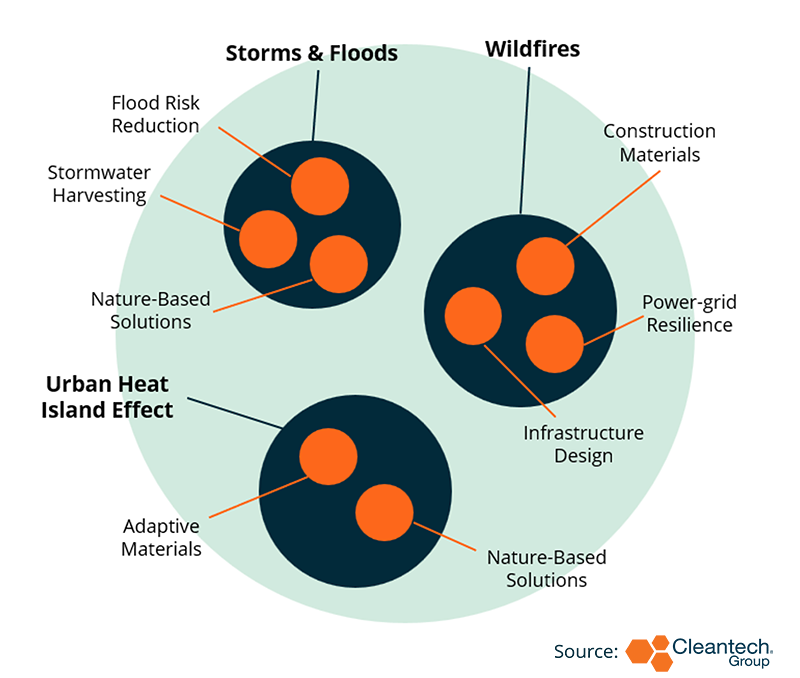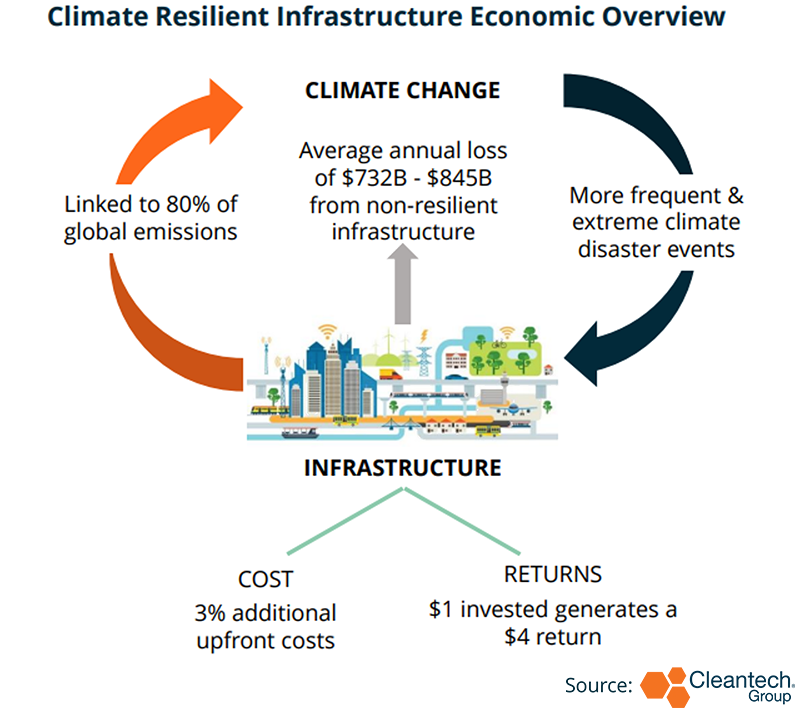As the planet grapples with increasingly severe weather events, our infrastructure faces a critical test. Buildings, utilities, and other physical assets must be fortified to withstand damage and maintain functionality during and after disaster events. While this challenge is immense, it also presents a golden opportunity for cleantech innovation to redefine how we build and adapt our world.
Why Climate-Resilient Infrastructure Matters
The most critical impact of incorporating climate-resilient infrastructure is that nothing happens – because physical damage and economic losses are mitigated.
Extreme weather has already cost the global economy over $2 trillion in the last decade, disproportionately impacting vulnerable communities. The average annual loss of having non-resilient infrastructure is estimated to be $732B – $845B.
Moreover, climate-resilient infrastructure addresses pressing environmental concerns, with 80% of global emissions tied to infrastructure materials and operations. A significant portion of these emissions comes from the embodied carbon in materials, which can be reduced by choosing sustainable materials and using smart design.
Innovations Shaping Resilience
To ensure that these physical, economic, and health losses are mitigated, cleantech solutions are at the forefront of innovation, with breakthroughs in materials, design, and nature-based solutions. Some examples include:

- Wildfire Resilient Infrastructure: Fireproofing buildings and critical infrastructure to withstand damage and reduce spread of fires
- Construction Materials: Fire-resistant material innovation in concrete, insulation, and coatings, e.g., FenX and Moxy
- Infrastructure Design: New infrastructure planning using 3D design innovation and firebreak landscaping, e.g., Emergent3D
- Power-grid Resilience: Fault detection technology to prevent fires caused by electrical infrastructure, e.g., Gridware
- Storm and Flood Resilient Infrastructure: Fortifying infrastructure to minimize damage and flooding during storms
- Flood Risk Reduction: Permeable concrete, underground reservoirs, and floating/elevated structures to minimize water accumulation, e.g., PaveDrain and AquiPor
- Stormwater Harvesting: Systems for capturing stormwater for reuse in non-potable applications, e.g., Rainwater Harvesting
- Nature-based Solutions: Restored wetlands, living shorelines, and green roofs to mitigate flooding, e.g., ECOncrete
- Urban Heat Island Effect: Solutions that reduce heat transfer, heat accumulation, and reduce cooling costs
- Adaptive Materials: Temperature-responsive and reflective materials that regulate building temperatures and send heat back into the atmosphere, e.g., Skycool Systems, Mimsi Materials, and Aeroseal
- Nature-Based Solutions: Urban forestry, green spaces, and vegetative infrastructure to cool urban areas, e.g., Afforestt
Bridging the Investment Gap
Despite its promise, the market for climate-resilient infrastructure technology is still in its infancy. Innovations in this space are often categorized as deep tech, requiring long timelines and significant capital to scale—characteristics that deter traditional venture capital investment.

Data: AXA, World Bank, UN Environment Program (UNEP), Coalition for Disaster Resilient Infrastructure (CDRI)
The annual investment needed to address global resilience deficits by 2050 is a staggering $9.2 trillion, yet most funding today targets preparedness and response rather than prevention. Governments, insurance providers, and large corporates are the primary drivers of demand:
- Government Role: Policies like the U.S. Bipartisan Infrastructure Law and Inflation Reduction Act have allocated over $50B for climate-resilient infrastructure. Tax incentives, green bonds, and grants can further attract private investment.
- Insurance Influence: In disaster-prone regions, resilience standards are becoming prerequisites for infrastructure insurance, directly shaping market demand.
- Corporate Partnerships: To scale effectively, start-ups must partner with large engineering and construction firms, embedding their technologies into mainstream projects.
Overcoming Barriers
Achieving widespread adoption of climate-resilient technologies isn’t without obstacles. Novel materials face challenges in sourcing, regulatory compliance, and integration. Additionally, long return-on-investment periods discourage funding, even as the cost of inaction grows. For example, regulatory discrepancies across regions complicate global scaling, while supply chain shocks can delay the production of niche materials.
These innovations often face challenges in scaling due to interoperability with aging infrastructure that require costly retrofitting and collaboration amongst multiple stakeholders. Additionally, the increasing severity and frequency of natural disasters creates a moving target, demanding increasingly adaptable and forward-looking solutions from innovators.
The Road Ahead
Despite these challenges, the benefits of climate-resilient infrastructure far outweigh its costs.
On average, each dollar invested in climate resilience yields a fourfold return in avoided repair and recovery costs, and these investments typically pay for themselves within two years in avoided damage costs. The human impact is undeniable—resilient designs could prevent up to 250,000 additional deaths annually during extreme weather events.
For start-ups and investors willing to navigate this complex landscape, opportunities abound. Technologies that can retrofit existing assets or integrate into smart city designs are poised for rapid adoption. Wildfire tech, in particular, is emerging as a high-priority segment, spurred by growing losses and new organizations like the Association of FireTech Innovation.
Innovation in this space has the power to transform infrastructure from vulnerable to resilient. By embracing novel materials, smart designs, and scalable solutions, our buildings, grids, and cities can withstand tomorrow’s climate challenges.


